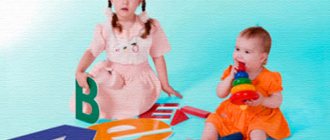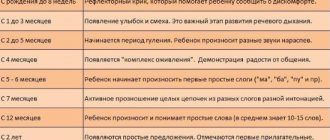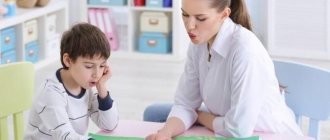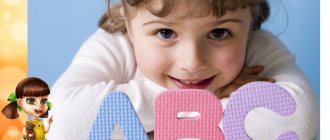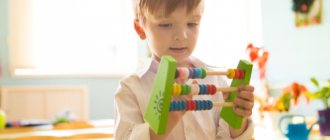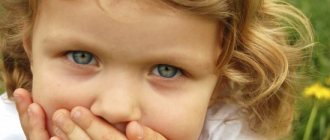Experts have different views on motor alalia of speech. There is an opinion that such a diagnosis can only be made to a child who is already speaking, since this is the language level of the disorder.
I will present the information as I understand it from the point of view of neuropsychology, based on the work of various researchers on this topic.
When we turned to a neurologist about my son Egor’s RRR, the doctor wrote us an interesting wording in the conclusion: “RRR of the type of motor alalia.” He was 2 years 9 months old. and he spoke with the first syllable, there was no phrase. A month later he started talking straight away in sentences. Formally, he was not given alalia. Well, delay and delay. But I see the alalic mechanism of the disorder, and I also see dyspraxia.
So, alalia is a term from the clinical and pedagogical classification. According to the psychological and pedagogical classification, speech therapists write “ONR” for this disorder - general underdevelopment of speech. That is, in one conclusion, separated by a comma, both can appear. However, not every OHP is alalia. I liked the idea of speech therapist Angelina Kartashova that alalia is the mechanism of the disorder, and OHP is the degree of severity.
The first cases of speech underdevelopment in children were described back in the 19th century. In the West, there is a term analogous to alalia - “developmental dysphasia.”
Motor alalia (a term from the book by A.N. Kornev) is a multisyndromic state of total underdevelopment of predominantly expressive speech, manifested in a primary violation of the formation of language operations of phonological, lexical and syntactic-morphological programming of utterances.
At the same time, motor alalia can occur in children with different levels of intelligence (even in children with) and motor development (sometimes in children with cerebral palsy).
The origin of motor alalia is complex. As a rule, two sets of reasons are combined:
- Genetic (heredity)
- Exogenous-organic (very often in the anamnesis - CS, fetal hypoxia, impaired blood supply to the brain, displacement of the vertebrae in the cervical spine, vascular problems).
Moreover, the greater the weight of residual organic factors, the more severe the speech underdevelopment will be. Also, alalia may be accompanied by peculiarities of mental development.
The prevalence of alalia is on average 2.7 cases per 1000 preschool children, while motor alalia is in 2nd place in terms of close connection with the male gender (autism is in first place). Interesting fact: with a simple form of motor alalia, the ratio is 1 girl with MA to 14 boys with MA. At the same time, MA complicated by psychoorganic symptoms and intellectual impairment will occur in the ratio of 1 girl to 2 boys. In other words, most girls suffer from a complicated form of motor alalia.
Among scientists, there is an opinion that the brain tissue of boys is more vulnerable, so even mild problems during pregnancy and childbirth can cause cerebral disorders in the fetus. Girls' brains are more resistant to damage, so only severe and extensive cerebral damage causes dysfunction. Therefore, in practice, speech problems in girls are often accompanied by disorders of non-speech mental functions. There is also a theory about the influence of hormonal levels on the maturation of speech centers in the cortex.
Forms of motor alalia in children
Depending on the location of the brain damage, the following types of motor alalia are distinguished: afferent and efferent.
Afferent (kinesthetic)
This form is caused by damage to the area of the cortex that is responsible for the kinesthetic control of the speech program. It is located in the inferior parietal region of the left hemisphere. At the same time, it is difficult for the child to reproduce words and sentences and find articulatory poses. That is, the baby does not know how to position his tongue, lips, teeth when pronouncing a word.
The condition is called oral-articulatory apraxia. Outwardly, it manifests itself by replacing sounds and distorting the structure of syllables.
Efferent (kinetic)
Efferent motor alalia develops due to damage to Broca's center - the posterior frontal areas of the brain. This zone is responsible for controlling the switching of articulatory acts. Children with this pathology find it difficult to follow the sequence of speech movements. As a result, the syllabic composition of the word is distorted, and speech slows down. In science, this syndrome is called kinetic apraxia.
There are also levels of motor alalia. This classification takes into account the degree of speech underdevelopment. At level 1, the baby is extremely limited, uses a few everyday words, and the basis of speech is onomatopoeia and babble. Level 2 is characterized by a wider range of words and the ability to compose short sentences. Level 3 of motor alalia is distinguished by the presence of phrasal speech.
Causes of motor alalia in a child
The development of motor alalia occurs due to damage to the motor centers of speech in the brain.
Depending on the time of exposure to the traumatic factor, there are:
- Prenatal factors are those that affect the fetus. This group includes infectious diseases of women during pregnancy (rubella, cytomegalovirus infection, toxoplasmosis are especially dangerous), diabetes mellitus, toxicosis, incompatibility of the fetus and mother according to the Rh factor, hypoxia. Brain damage can also be caused by severe stress, physical trauma of a woman, taking medications that are contraindicated during this period, taking alcohol and drugs, smoking;
- Intranatal factors are those that act during childbirth. These include birth injuries to the brain and asphyxia. These factors lead to the death of neurons. Stimulation of labor, rapid labor, the use of obstetric forceps, premature rupture of water, premature placental abruption, and entanglement of the umbilical cord have a negative impact;
- Early postnatal factors. This group includes traumatic brain injuries, meningitis, encephalitis, and brain tumors that occurred in the first year of a child’s life. Infectious diseases, anemia, rickets, and malnutrition can also have an effect. A special role is played by a lack of communication, attention from parents, and emotional upheavals at an early age (separation from mother, for example).
A characteristic feature: the earlier and longer the negative factor was exposed, the more pronounced the motor alalia, the more serious the consequences and the more complex the prognosis.
Signs of motor alalia in children
Symptoms vary in severity: from minor difficulties that practically do not interfere with normal life, to a complete absence of spoken language. Both the phonetic-phonemic and lexical-grammatical components suffer.
At an early age, the pathology is characterized by poor speech reactions. A 2-year-old child may have no babbling at all. Children actively use gestures, onomatopoeia, and primitive babble to communicate.
A child only develops his first words at the age of 3 or a little later. And at the same time he confuses sounds, replaces them, skips them. Can repeat syllables or individual sounds, connect inappropriate syllables from different words.
A 4-year-old child has a poor vocabulary, the phrases are incomprehensible and incorrectly composed. And in the future, he mainly uses nouns, ignores conjunctions, prepositions, and very rarely uses adjectives, verbs, adverbs, and function words. Words do not agree in cases, numbers, genders and tenses. He divides words when speaking and speaks slowly.
A baby cannot repeat sounds after an adult, not to mention phrases. He cannot relate the word and the situation, so he uses words incorrectly.
At the same time, the child understands the addressed speech: he can fulfill the request or respond with a gesture.
Symptoms of psychological and neurological disorders are also observed. Such children, as a rule, are not very active. They are calm about their condition. In general, they are clumsy and have poor coordination and fine motor skills. For example, it is difficult for them to thread a needle, pick up a small object and transfer it.
Attention, memory, and thinking suffer. Children have an unstable emotional background, they are whiny, which makes communication with others even more difficult. There may be sleep and appetite disturbances.
Alalia of speech in children. Forms and causes of speech alalia. Motor, sensory, sensorimotor.
alalia in children, symptoms of alalia, speech alalia, alalia in children symptoms, alalia work, treatment of alalia, speech alalia, alalia occupation, signs of alalia, treatment of alalia in children, speech therapy alalia, speech of a child with alalia, signs of alalia in a child, alalia dysarthria , alalia prognosis, 2 alalia, alalia child 3 years old, alalia speech disorder, alalia stages of work, working with children with alalia, alalia 2 years, diagnosis of alalia, speech therapist alalia, alalia per year, correction of alalia, alalia aphasia, forms of alalia, alalia 4 years, levels of alalia, speech disorders alalia, alalia correctional work, alalia speech therapy work, development of a child with alalia, alalia study, types of alalia, prognosis of alalia in a child, 4 year old child alalia, mechanism of alalia, causes of alalia, alalia download, alalia in children 2 years old, characteristics of alalia, alalia features, activities for children with alalia, alalia in children symptoms 3, alalia in children symptoms 3 years old, alalia dyslalia, alalia in children forum, diagnosis of alalia, mental health alalia, onr alalia, alalia speech development, alalia notes, alalia how to treat, classification of alalia, logorhythmic lesson with alalia, logorhythmic lesson for children with alalia, alalia in children symptoms 2 years old, degrees of alalia, concepts of alalia, alalia symptoms in children forecasts, alalia in speech therapy, alalia questions, cured alalia, characteristics of children with alalia, alalia lesson notes, the difference between alalia and autism, alalia work at the initial stage, exit from alalia, alalia delayed speech development, alalia with mental retardation, studying children with alalia, examinations of a child with alalia, auditory alalia, correctional work with motor alalia, speech therapy work with children + with alalia, structure of alalia, alalia symptoms treatment, alalia benefits, manifestation of alalia, alalia techniques, alalia stuttering, alalia disease, alalia speech therapy classes, work with children with motor alalia, alalia table, alalia dysarthria dyslalia, sensory alalia disorder, alalia authors, buy alalia, definition of alalia, alalia at 3 years, correctional work + for alalia stages, concepts of alalia mechanisms, alalia occurs when, alalia treatment prognosis, characteristics of children with alalia, treatment of alalia reviews, alalia program, alalia stages of speech therapy work, alalia video, alalia center, alalia exercises, apraxia alalia, overcoming alalia, alalia can be cured, children's alalia, conclusion of alalia, alalia work of a speech therapist, alalia anamnesis, notes of children's classes with alalia, alalia fine motor skills, alalia children 5 years old, alalia games, disability + with alalia, alalia disease, psychological alalia, organic alalia, alalia tastes, alalia components, alalia symptoms forum, levels of speech development + with alalia, alalia syndrome, speech alalia in children, can alalia be cured , treatment of alalia in children reviews, alalia and rhinolalia, lesson alalia 3 years, correctional work with children with alalia, alalia 6 years old, alalia as a systemic disorder of speech activity, alalia is treated or not, alalia in children symptoms forum, alalia echolalia, occurrence factor alalia, speech of a child with motor alalia, alalia types of alalia, alalia ICD, alalia test, examination for alalia, alalia occurs + with damage, sensory alalia occurs + with, is alalia treated, alalia tasks, is alalia treated in children, alalia examples, symptoms alalia, alalia is curable, alalia varieties, biological factor of alalia, alalia prognosis for recovery, speech impairment in children alalia, differential diagnosis of alalia, alalia races, alalia massage, speech therapy session with a child with alalia, alalia in children symptoms and treatment, alalia first words . approaches, examination of the speech of children + with alalia, alalia is characterized by a disorder, summary of an individual speech therapy lesson alalia, causes of alalia in children, alalia is speech underdevelopment, alalia is a disorder, signs of alalia in children 2, crossword puzzle alalia, etiology of alalia, complications may accompany alalia, signs of alalia in children 2 years old, children with expressive alalia, identified expressive and impressive alalia, alalia onp level 1, general underdevelopment of speech alalia, alalia with autistic features, alalia work at the initial stage download, psychological characteristics of children with alalia, the causes of alalia are, echolalia are typical + for alalia, alalia disorder of sound pronunciation, alalia rehabilitation, alalia eeg, speech therapy massage + for alalia, speech symptoms of alalia, efferent alalia, cerebral palsy alalia, causes of alalia, alalia is, alalia textbook, linguistic classification of alalia, alalia work on the initial stage of formation, Maria Chernyak, a guide to alalia, speech therapy report on alalia, children with alalia at school, the behavior of children with alalia, features of the cognitive sphere of children + with alalia, alalia happens, alalia is 7 years old, non-speech disorders are accompanied by alalia, is alalia curable, delay speech alalia, alalia ICD code, mechanism of occurrence of alalia, alalia in children symptoms prognosis + and treatment, speech delay alalia, alalia represents, alalia happens, alalia systemic speech disorder, is alalia curable, alalia speech initiation, alalia logorhythmics, alalia in children symptoms 2 years signs, alalia lecture, onp level 2 alalia, alalia ICD code, alalia refers to disorders, alalia in children examples, alalia scheme, raising children with alalia, alalia how to deal with a child, alalia work plan, semantic alalia, treatment centers alalia, alalia is cured, what non-speech disorders are accompanied by alalia, alalia when she speaks, alalia cards, speech therapy alalia aphasia, disability with alalia in children, alalia systemic speech disorder, alalia card index, alalia work plan, do they give disability with alalia, differentiation of alalia, what non-speech disorders are accompanied by alalia, syntactic alalia, echolalia what alalia, alalia is characterized as, recommendations alalia, alalia work program, criteria for alalia, program for children with alalia, mechanisms of expressive alalia, psychological classification of alalia, main stages of alalia, alalia 1st degree, alalia when speaks, alalia consequences, alalia in children treatment reviews from parents, alalia home activities, alalia dyspraxia, signs of alalia in a 4 year old child, types of forms of alalia, scientist who developed the linguistic classification of alalia, what kind of speech suffers from alalia, course alalia, types of alalia table, signs alalia at 2 years old, alalia disability group, correctional intervention + for alalia, traugott alalia, treatment of alalia in children at home, logotherapy of alalia, alalia treatment in Moscow, alalia 9 years old, alalia correctional work system, forms of alalia table, alalia ICD 10 code , memory for alalia, speech therapy examination of alalia, alalia what kind of disease is this, symptoms, alalia ru forum for parents, autism alalia in children, speech disorders alalia aphasia, treatment of alalia in children at home, alalia boys, alalia medications, logorhythmic games for children with alalia, main forms of alalia, alalia lectures video, MRI + for alalia, akatinol for alalia, alalia translation, signs of alalia in children 3 years old, alalia symptoms at 3 years old, erased alalia, treatment of alalia St. Petersburg, Smirnova alalia dysarthria onr, alalia Wikipedia, speech symptoms of alalia, methods for correcting alalia, congenital alalia, alalia in adulthood, cortexin for alalia, signs of alalia in children 3, visual methods of working with children with alalia, alalia and other disorders, production of sounds for alalia, pantogam for alalia, non-speech disorders with alalia, systemic speech disorders alalia aphasia, tasks for children with alalia, sound pronunciation of children with alalia, the difference between alalia and SRR, sound pronunciation of children with alalia, methods for correcting alalia, alalia oh as you want, stages of correction of alalia, pantogam for alalia, intelligence for alalia , alalia reading training, speech therapy alalia aphasia answers, methods of examining children with alalia, gliatilin + for alalia, diagnosis of alalia and dysarthria, alalia according to ICD 10 in children, characteristics of forms of alalia, alalia treatment drugs, systemic speech disorders alalia aphasia, tank for alalia reviews
Diagnosis of motor alalia in children
The examination is carried out with the participation of several specialists. The medical part of pathology is dealt with by a neurologist, otolaryngologist, and pediatrician. Consultation with a speech therapist and psychologist is required. At this stage, specialists are faced with the task of making an accurate diagnosis, identifying the degree of impairment, and excluding other speech disorders.
Diagnostics include:
- Medical examination - history taking, examination of a small patient. Any details are important: how the mother’s pregnancy and childbirth proceeded, how the newborn period progressed, features of physical and neuropsychic development. A neurologist identifies problems with motor skills, poor coordination of movements, uneven reflexes, decreased or increased muscle tone. Electroencephalography, Doppler examination of cerebral vessels, and MRI help determine the diagnosis and cause of the disorders;
- A speech therapy examination consists of assessing speech and its levels of development. The specialist uses tests to determine the volume of vocabulary, level of speech development, grammar, syllable structure and other indicators. The movements of the lips and tongue, the accuracy of these movements, and articulatory switches are assessed;
- Psychological examination - assessment of the emotional-volitional sphere and cognitive abilities by a psychologist. For motor alalia in preschoolers, testing is carried out in the form of games so that the child can fully open up and the specialist can actively monitor the patient’s behavior, simulating various situations.
Having received complete information about the patient, specialists determine treatment tactics and prognosis.
Massage technique
When treating alalia, speech therapy massage is very effective, stimulating speech zones. A full massage cannot be performed without qualifications and the use of special probes. Under the guidance of a specialist, parents can learn the simplest techniques of massaging the face, hands, lips, tongue and carry them out at home on their own. To do this, you can use teaspoons with smooth edges and your mother’s clean, warm hands. Elements of the massage are performed 5 times, all exercises begin and end with stroking.
Sequence of massage movements:
- stroking the forehead from the center to the temples, temples clockwise using the convex side of a spoon or hands;
- the eye sockets are ironed in the same way;
- cheeks are stroked in a circle;
- then the space between the eyebrows is massaged;
- The nose is rubbed, the lip and tongue are massaged.
Hand and face massage is carried out in a warm room. The massage therapist's hands are pre-treated with an antiseptic.
By massaging a child's hands, he develops fine motor skills associated with brain function and speech. It can be performed not only with your hands, but also with rubber balls, prickly curlers, Su Jok. Hand warm-up begins with the little finger, first from its outer side. Then it is recommended to move up along the finger, gently pressing on the pads, then rubbing them. After warming up the palm, its inner side is massaged.
Treatment of motor alalia in children
The therapy is complex, aimed at eliminating the cause of the disease, correcting disorders, influencing the sensory, intellectual, emotional and volitional sphere. A psychologist/neuropsychologist, a neurologist, and a speech therapist/speech pathologist work with the patient.
It is advisable that treatment of motor alalia, regardless of the symptoms, be started as early as possible. The optimal period is 3–4 years. Preschoolers are easy to correct; moreover, no violations were recorded at this age. Another important condition is the regularity of the exercises.
The medical part of the correction consists of drug therapy, physiotherapy, and massage. These procedures eliminate brain disorders, restore blood flow in blood vessels, and improve motor function.
Psychological treatment for signs of motor alalia in children is aimed at improving memory, attention, thinking, and control of the emotional-volitional sphere.
Clinical picture and behavioral characteristics of children
With motor alalia, a child may have a large passive vocabulary, but finds it difficult to name even well-known words. Children cannot repeat even simple words after an adult, despite having a developed articulatory apparatus. In words they rearrange and replace syllables, omit sounds. These substitutions are not permanent; in some circumstances, children replace syllables, in others, they replace sounds in the same word.
It is especially difficult for them to pronounce words expressing abstract concepts and generalization words. Children with alalia are aware of their shortcomings. A child with high intelligence is more critical of his speech; when communicating with others, he replaces words with facial expressions and gestures. When parents have excessive demands on pronunciation, when the speech therapist tries to “introduce” sounds, despite the fact that those around him do not understand him, he shows negativism.
The scarcity of phrasal speech is very noticeable - children speak in simple sentences or sentences consisting of only subjects. If you don’t work with your baby, he won’t be able to master the grammatical structure of speech. Children make mistakes in agreeing nouns with prepositions and use case endings incorrectly.
With age, more and more automation of speech is required, and afferent motor alalia in children only increases the child’s problems. Children suffering from this pathology are diagnosed with disorders of attention, memory, thinking, analysis and synthesis of words and phenomena, emotions, will, and behavior.
The symptoms of alalia exclude balanced behavior - it is not often found in children with this speech disorder; usually they are either inhibited or too excited. Most children have impaired fine and gross motor skills, are clumsy, and their movements are disinhibited or slow.
A child with alalia has little desire to understand the surrounding reality; he is inattentive and often distracted. Visual and auditory memory in such children is reduced; such children do not strive for intellectual activity. In the process of completing tasks, they do not strictly follow instructions and therefore often make mistakes.
Corrective work
Speech therapy correction includes several areas and stages:
- Stimulation of speech activity. At the initial stage, it is important to create motivation, activate speech reactions, teach to imitate someone else’s speech, and enrich the vocabulary. The baby also learns to conduct a dialogue. It is easier to achieve results if you use a game form of training;
- Stimulation of phrasal speech. This stage begins after the baby has formed a certain set of words and develops the skill of conducting a dialogue. Then it becomes possible to construct simple sentences that gradually become more complex. At the same time, children learn the correct construction of words and sentences, grammatical errors disappear from their oral speech;
- The development of coherent speech involves teaching a child how to conduct a monologue or story. He learns to formulate a thought, retell what he read or heard, compose a story based on a picture, and compose. Grammar is reinforced;
- Elimination of phonetic-phonemic disorders through various exercises. The baby learns to pronounce sounds correctly, focusing on the position of the organs of articulation during classes and in everyday life. Over time, such control becomes automatic.
We would like to note the role of parents in the development of speech in a child. It is important to encourage his successes and his speech activity in every possible way. But if something doesn’t work out yet, you shouldn’t scold him.
Possible complications and consequences
Due to the fact that expressive speech is impaired, a child with motor alalia does not communicate well with others and peers. Thinking, memory, perception, imagination suffer. All this undoubtedly leaves its mark on development. Alalik is afraid to contact strangers, this is especially pronounced in a new environment. Even with children of the same age, he cannot find a common language and build communication.
Preschoolers in kindergarten stay apart. At school they have difficulties with writing, reading, and mastering grammar. In some cases, the disease is complicated by stuttering, which further complicates the prognosis.
Parents should understand how to treat motor alalia in a child and that this disease is not a developmental disorder and is not a temporary phenomenon. This is a disorder of speech formation, which is accompanied by a pathological process in the central nervous system. Often mothers and fathers make the mistake of believing that their baby is developing normally, and speech impairment is a variant of the norm at that age. As a result, the disease is diagnosed in late stages and the possibility of a complete cure is in question.
Sensory alalia
This is a developmental defect in which the patient does not speak himself. He is also unable to understand the words that are addressed to him. Among children who suffer from problems associated with the speech apparatus, sensory alalia occurs only in 10% of cases.
With sensory alalia, the child does not understand the speech of others, and his speech does not develop. Speech impairment in this case is secondary in nature, as it is associated with problems related to misunderstanding of the speech of others and impaired phonemic hearing.
This form of alalia is accompanied by underdevelopment or damage to the speech-hearing analyzer. As a result, the child is unable to connect sounds heard from adults into words.
Prognosis and prevention
The result depends on the type of motor alalia, the severity, and the age at which the disease was diagnosed and therapy was started. If all these conditions are met and adequate treatment is provided, the prognosis is favorable. Children catch up with their peers in speech and general development, acquire communication skills and even study in a regular school.
Severe motor alalia is difficult to correct, especially if it is diagnosed late. But with due persistence and following the doctor’s recommendations regarding treatment, it is possible to achieve significant progress.
Prevention of motor alalia begins during pregnancy planning. The expectant mother needs to eliminate bad habits, adjust her diet and daily routine. It is necessary to approach childbirth adequately and prevent injuries. It is also important to create favorable conditions for the development of the child in the postpartum period and subsequently, to devote time to developmental activities.
And of course, it is necessary to consult a doctor at the first signs of deviations in speech development in order to undergo a timely diagnosis and identify the cause.
Alalia symptoms
Symptoms of motor alalia
With expressive alalia, the child is diagnosed with psychological and neurological abnormalities. Symptoms of nervous disorders can manifest themselves in a disorder of motor skills: poor motor skills, clumsiness, lack of coordination of movements. Such children find it difficult to cope with lacing shoes, fastening buttons, self-care, and putting together puzzles.
Characteristic features of the psychological development of patients with motor alalia:
- speech negativism;
- lack of attention;
- small vocabulary;
- low performance;
- poor assimilation of material;
- violation of sound pronunciation;
- deviations of the emotional-volitional sphere;
- hyperactivity or, conversely, inactivity.
It should be noted that there is a strong dissociation between expressive and impressive speech when diagnosed with “motor alalia”. The first speech skills (babbling, googling, sounds, phrases) appear with a delay and a characteristic reduction. The lack of dynamic development of a speech stereotype can be a consequence of stuttering.
Such children have a predominance of nouns in the nominative case in their vocabulary and difficulties in the formation of grammatical word forms. Speech in the motor form of the disease consists of simple short sentences, sometimes incoherent. The child is not able to consistently talk about things, convey events and explain the essence of phenomena. Intellectual development with motor alalia can be completely restored after correction of speech disorders.
Symptoms of sensory alalia
Characteristic symptoms of sensory alalia are:
- disturbances of perception;
- lack of ability to understand the meaning of someone else's speech.
Patients with sensory alalia experience hyperacusis: increased sensitivity to squeaks, rustles, the crunch of snow, the sound of rain, and the rustling of paper. Children are acutely aware of such side sounds and may experience discomfort in their ears and head.
Impaired phonemic hearing in the sensory form of the disease prevents patients from correlating heard words with objects or phenomena. During speech therapy sessions, children with sensory alalia develop logorrhea - incoherent reproduction of all familiar phrases and sounds, while speech is accompanied by gestures and lively facial expressions.
In the severe form of sensory alalia, the patient is diagnosed with a complete lack of speech and understanding of others. Experts practice teaching “lip reading,” which makes it much easier for a child to comprehend speech. Children with sensory alalia are often misdiagnosed as autism, hearing loss, mental retardation, dysarthria.
Separately, sensory underdevelopment of speech function is quite rare. In most cases, sensorimotor alalia is diagnosed. This double pathology indicates the inseparability of the speech-motor and speech-auditory analyzers.
If you experience similar symptoms, consult your doctor
. It is easier to prevent a disease than to deal with the consequences.
